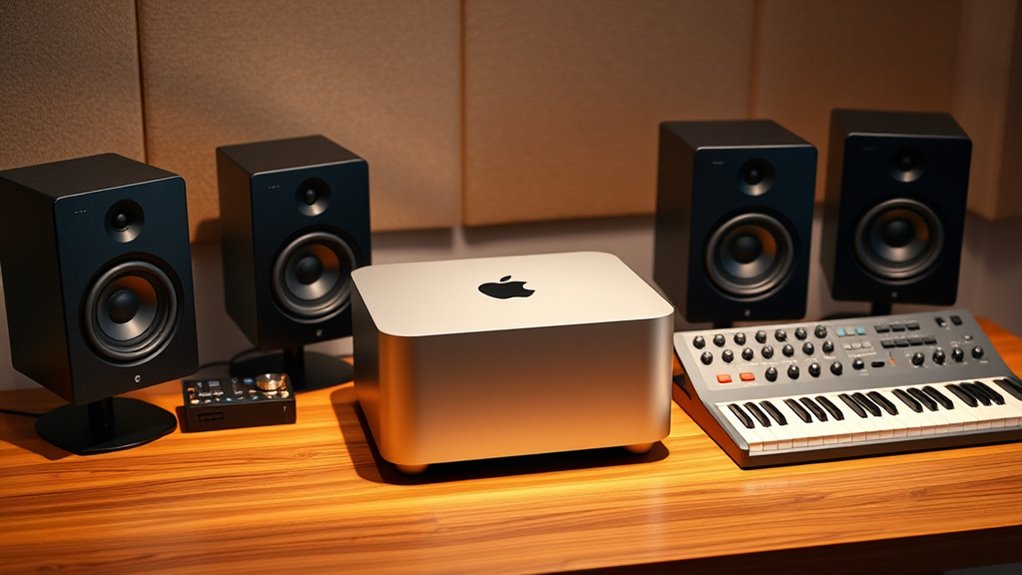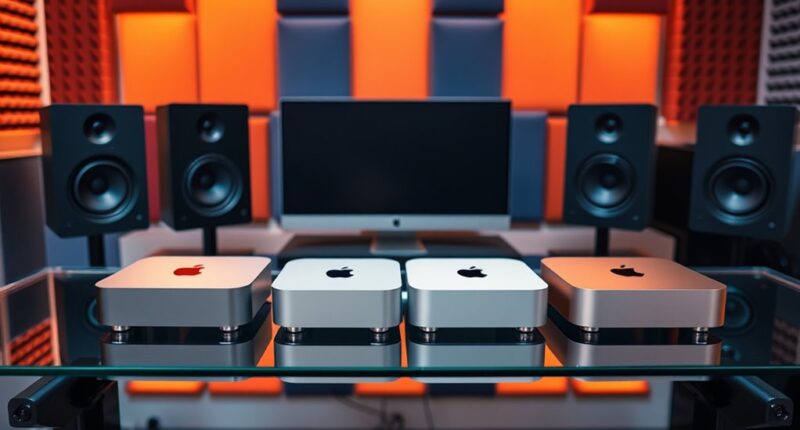If you’re looking for the best Mac mini models for your home studio in 2025, I recommend considering the Apple Mac mini with the M4 Pro chip, as it offers powerful processing, excellent graphics, and support for multiple high-res displays. The Mac mini with M4 and 24GB RAM is also a solid choice for smooth multitasking, while models with larger SSDs give you more storage. To find the perfect fit, I’ll walk you through the top options and what makes each special.
Key Takeaways
- The latest Mac Mini M4 Pro offers powerful CPU and GPU performance, ideal for demanding studio tasks in 2025.
- Compact aluminum design ensures space efficiency and quiet operation, perfect for home studio environments.
- Extensive Thunderbolt 4/5 and HDMI ports support multiple high-resolution monitors and audio interfaces.
- Configurable storage up to 8TB and up to 24GB RAM provide future-proofing for creative workflows.
- The M4 chip models deliver up to 20% faster performance, making them suitable for video editing, music production, and multitasking.
Apple Mac mini Desktop Computer with M4 Chip, 24GB RAM, 512GB SSD
If you’re setting up a home studio in 2025, the Mac mini with the M4 chip, 24GB of RAM, and 512GB SSD is an ideal choice for those who need powerful performance in a compact form. Its sleek aluminum design measures just 5 x 5 inches and weighs only 1.5 pounds, making it highly space-efficient. Despite its small footprint, it offers extensive connectivity, including Thunderbolt 4, HDMI, and USB-C ports. Powered by the M4 chip, it delivers a significant boost in CPU, GPU, and AI tasks. It supports multiple high-resolution displays and handles demanding creative workflows like video editing and 3D rendering effortlessly.
Best For: creative professionals and home studio enthusiasts seeking powerful, space-saving performance in a compact desktop.
Pros:
- Compact, sleek aluminum design measuring only 5 x 5 inches and weighing just 1.5 pounds
- Powerful M4 chip with significant improvements in CPU, GPU, and AI tasks, ideal for demanding workflows
- Supports multiple high-resolution displays and extensive connectivity options for versatile setups
Cons:
- Lack of USB-A ports may require adapters for older peripherals
- Base model’s 16GB RAM might limit performance in very intensive tasks
- Relocated power button could reduce intuitive operation for some users
Apple Mac mini 2024 Desktop with M4 Pro Chip
The Apple Mac mini 2024 with the M4 Pro chip stands out as an ideal choice for home studio enthusiasts who need powerful performance in a compact form factor. Its small size—5×5 inches and just over 1.5 pounds—fits easily on a desk or next to your monitor. Powered by the 12-core M4 Pro CPU and 16-core GPU, it handles demanding tasks like video editing and 3D rendering effortlessly. With support for up to three displays and fast Thunderbolt 5 connectivity, it’s versatile for creative workflows. Despite limited ports, its energy-efficient, quiet operation makes it perfect for a space-conscious, high-performance home studio setup.
Best For: home studio enthusiasts and creative professionals seeking a compact, high-performance desktop for demanding tasks like video editing and 3D rendering.
Pros:
- Small, lightweight design easily fits into any workspace
- Powerful M4 Pro chip with high-end CPU and GPU for demanding creative tasks
- Supports up to three displays and fast Thunderbolt 5 connectivity for versatile workflows
Cons:
- Limited ports requiring adapters for USB-A peripherals
- Power button placement may be less intuitive for some users
- Base model’s 24GB memory might restrict very intensive multitasking or large projects
Apple Mac mini Desktop Computer with M4 Chip (2024)
Designed for power and compactness, the Apple Mac mini with M4 chip (2024) stands out as an ideal choice for home studio enthusiasts who need a small but mighty workstation. Its compact 5×5-inch aluminum design weighs just 1.5 pounds, fitting easily next to your monitor or in tight spaces. Despite its size, it packs a 10-core CPU, 10-core GPU, and 16-core Neural Engine, delivering up to 20% faster performance. With up to 32GB of unified memory and fast SSD options, it handles demanding creative tasks smoothly. Its extensive connectivity, support for multiple high-resolution displays, and quiet operation make it a versatile, space-saving powerhouse perfect for home studios.
Best For: home studio enthusiasts and creative professionals seeking a compact, powerful workstation with excellent connectivity and performance.
Pros:
- Small, space-saving design perfect for tight environments and home studios
- Powerful M4 chip with up to 20% faster CPU and enhanced graphics for demanding creative tasks
- Quiet operation with minimal noise, ideal for noise-sensitive settings
Cons:
- Lack of USB-A ports may require adapters for legacy peripherals
- Base model’s 16GB memory could be limiting for intensive workflows
- Power button relocated to the bottom, potentially less intuitive for some users
Apple Mac mini Desktop Computer with M4 Chip (512GB SSD, 16GB RAM)
For home studio professionals seeking compact yet powerful hardware, the Apple Mac mini with M4 chip (512GB SSD, 16GB RAM) stands out as an ideal choice. Its small footprint—just 5 inches square and 1.5 pounds—fits easily into any workspace. Despite its size, it offers robust connectivity, including Thunderbolt 4, HDMI, Ethernet, and USB-C ports. Powered by the efficient M4 chip, it delivers impressive performance for audio production, video editing, and multitasking. The device runs quietly, stays cool, and supports multiple high-resolution displays. Its sleek aluminum design and energy efficiency make it a reliable, space-saving powerhouse for home studios.
Best For: home studio professionals and creative users seeking a compact, high-performance desktop for audio, video editing, and multitasking.
Pros:
- Compact and lightweight design ideal for small spaces
- Powerful performance with M4 chip, supporting multiple high-resolution displays
- Quiet operation and energy-efficient, maintaining cool and minimal noise
Cons:
- Lack of USB-A ports, requiring adapters for some peripherals
- Power button placement may be less intuitive for some users
- Base model’s 16GB RAM may limit demanding workflows without upgrades
Factors to Consider When Choosing Mac Mini for Home Studio Workstations

When selecting a Mac Mini for your home studio, I consider factors like processing power, memory, and storage to ensure it meets my workflow demands. Connectivity options and display compatibility are also vital for integrating various gear and monitors seamlessly. By understanding these points, you can choose a model that best supports your creative setup.
Processing Power Needs
Choosing the right Mac Mini for your home studio hinges on understanding your processing power needs. Higher processing power means faster rendering and editing, especially in demanding audio, video, and 3D applications. Multi-core CPUs, like 12-core or 10-core options, greatly enhance multitasking and real-time processing, which is essential for complex workflows. Adequate processing speed reduces lag and improves stability during resource-intensive tasks such as live streaming or audio processing. If your projects involve large files, multiple plugins, or real-time effects, investing in a more powerful processor is necessary. The processor choice directly impacts your studio’s speed and efficiency, influencing your productivity and creative flexibility. Matching your CPU with your workload ensures smoother operation and better overall performance in your home studio.
Memory Capacity Limits
Memory capacity is a key factor to contemplate when selecting a Mac Mini for your home studio. The latest models with M4 or M4 Pro chips top out at 24GB or 64GB of unified memory, respectively. Most base models come with 16GB, which might be enough for light tasks but can limit performance during demanding workflows like audio production or video editing. Upgrading memory at purchase is essential because most Mac minis don’t support post-purchase RAM upgrades. Insufficient memory can cause slower response times and bottlenecks, especially when running multiple or resource-heavy applications. To future-proof your setup, opting for higher memory configurations is wise, ensuring smooth performance as your creative needs and software demands grow over time.
Storage Options Flexibility
Selecting the right storage options for your Mac Mini is crucial to guarantee your home studio runs smoothly and efficiently. With storage ranging from 256GB to 8TB SSD, you can choose a capacity that fits your project needs. The SSDs are upgradable at the time of purchase, allowing you to customize your setup and plan for future expansion without replacing the entire device. External storage solutions, connected via Thunderbolt or USB-C, add flexibility and extra capacity, making it easy to back up or access large media files. This combination of internal upgrades and external drives creates a scalable storage system tailored to your workflow, whether you’re working with small projects or massive media libraries. Flexibility in storage options ensures your Mac Mini stays responsive and capable as your needs grow.
Connectivity Requirements
To make certain your Mac Mini can handle all your home studio gear seamlessly, it’s crucial to pay close attention to its connectivity options. Ensure the model has enough USB-C, Thunderbolt, HDMI, and Ethernet ports to connect your audio interfaces, MIDI controllers, and external storage devices. Opt for models with multiple Thunderbolt 4 or Thunderbolt 5 ports, supporting high-speed data transfer and daisy-chaining peripherals. Check if the Mac mini supports the display outputs you need, such as dual 6K displays or 4K monitors, to create an efficient workspace. Also, verify compatibility with high-impedance headphones and audio interfaces to ensure quality sound output. Keep in mind that newer models may lack USB-A ports, so you might need adapters or hubs for legacy peripherals.
Display Compatibility
When setting up your Mac Mini as a home studio workstation, display compatibility becomes a key factor. I recommend choosing a model that supports multiple high-resolution external displays, like two 6K screens and a 4K or 5K monitor, to suit your visual workflow. Make sure it has HDMI 2.1 or Thunderbolt 4/5 ports, which handle higher bandwidths for seamless 8K or multi-display setups. Check the maximum number of supported displays—up to three—and their resolutions to prevent limitations. For color-critical work, ensure the Mac Mini’s media engines support HDR formats such as Dolby Vision, HDR10+, and HLG for accurate color grading. Also, verify compatibility with your display connections and adapters, especially if you’re using older monitors relying on USB-A or DisplayPort.
Noise and Cooling
Because Mac Minis are designed with energy-efficient M4 and M4 Pro chips, they operate quietly even under heavy workloads. Their minimal fan noise means I can focus on my music without distractions. The compact aluminum chassis helps dissipate heat effectively, keeping temperatures stable during intense sessions. Reduced internal components and optimized cooling systems generate less heat overall, contributing to quieter operation. Proper ventilation and placement away from heat sources further enhance cooling performance and prevent overheating during extended use. Remarkably, some models lack traditional fans altogether, which minimizes noise even more. This quiet operation is essential for creating an ideal home studio environment, allowing me to record and produce without the background hum or fan noise interfering with my work.
Port Accessibility
Choosing the right Mac Mini for your home studio depends heavily on port accessibility, as it determines how easily you can connect your peripherals and equipment. Make sure the model has the ports you need, like USB-A or USB-C, based on your gear. Consider the placement of these ports; front-facing ports are more convenient for frequently connected devices during sessions. It’s also important that the Mac Mini supports multiple high-speed connections simultaneously, such as Thunderbolt 4 and HDMI, to keep your workflow seamless. Keep in mind that newer models may have eliminated USB-A ports, so you might need adapters or hubs for legacy devices. ultimately, check the location of the power button—its placement can impact ease of use when powering your workstation on or off regularly.
Budget Considerations
Budget considerations play a crucial role in selecting the right Mac Mini for your home studio, as prices can vary considerably depending on the model and configuration. Start by determining your budget range to narrow down options, since models range from affordable entry-level to high-end setups. Keep in mind the cost of additional peripherals and adapters, especially because newer Mac Minis lack USB-A ports, which may require extra purchases. Balance your desired specs, like RAM and storage, with what fits your budget to avoid overspending on unnecessary features. Higher-end models, such as those with M4 Pro chips and larger SSDs, come at a premium. Also, consider potential upgrades or accessories needed for ideal performance, as base models might require extra investment to meet your studio needs.
Frequently Asked Questions
How Does the M4 Pro Chip Improve Audio Processing Capabilities?
The M4 Pro chip boosts audio processing by offering faster, more efficient performance and advanced neural engine capabilities. I notice quicker response times and smoother handling of multiple tracks and plugins. Its improved architecture reduces latency, which is essential for real-time monitoring and editing. Overall, it enhances my creative workflow, allowing me to focus more on making music without worrying about delays or processing bottlenecks.
Can Mac Mini Models Support Multiple External Monitors Effectively?
Yes, Mac Mini models can support multiple external monitors effectively. I’ve set up my Mac Mini with dual 4K displays, and it handles both seamlessly thanks to its Thunderbolt and HDMI ports. The newer models have improved graphics and processing power, making multitasking smooth. If you plan to run multiple monitors for your studio work, I recommend checking the specific model’s port options and ensuring your monitors are compatible for a flawless setup.
What Are the Best Ports for Audio Interfaces on These Mac Minis?
The Thunderbolt 3 or 4 ports are your best bet for audio interfaces, offering fast, reliable connections like a steady stream of clear sound. They handle high-quality audio data effortlessly, reducing latency. I always favor these ports because they give me peace of mind, knowing my recordings are crisp and my workflow remains smooth. Think of them as the highway for your audio gear — direct, efficient, and dependable.
How Upgradeable Are the RAM and Storage Options on These Models?
I can tell you that the RAM and storage options on these Mac Minis are pretty limited when it comes to upgrades. Most models have soldered RAM, which means I can’t upgrade it later, and the storage is usually not user-accessible. If you’re planning to expand, it’s best to choose a configuration with the desired specs upfront. I recommend selecting higher RAM and storage during purchase to avoid future limitations.
Do Newer Mac Mini Models Have Better Thermal Performance for Long Sessions?
Imagine a race car handling long, intense sessions—newer Mac Minis are much like that. They feature improved thermal designs, helping them stay cool during extended use. This means better performance and less throttling over time. I’ve found that Apple’s recent models are engineered to handle demanding workloads, making them ideal for home studio work where sustained performance matters. So, yes, newer Mac Minis excel in thermal performance for long sessions.
Conclusion
Choosing the right Mac mini for your home studio is like finding the perfect brush for a masterpiece. Each model offers unique strengths, whether it’s power, speed, or storage. Think of it as assembling a toolkit tailored to your creative needs. With the right choice, you’ll turn your workspace into a symphony of productivity and inspiration. So, pick wisely, and let your creativity flow like a river carving its path to greatness.











